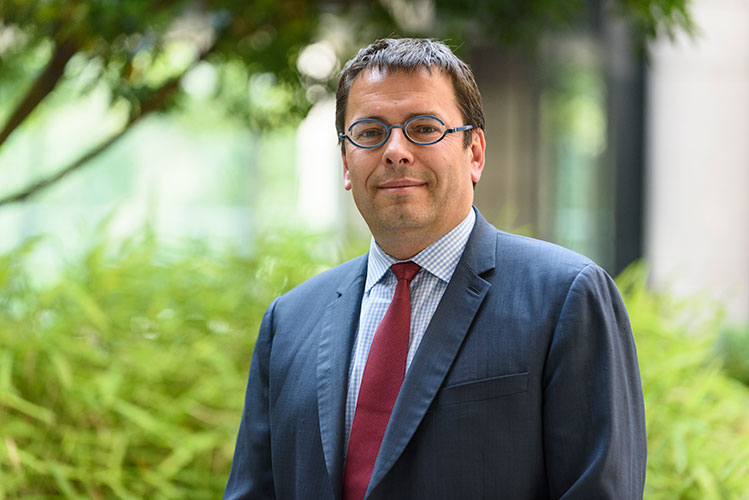
Nicolas Notebaert, CEO of VINCI Concessions and President of VINCI Airports: “With the acquisition of Belfast International, we take a step into the UK market, which is quite strategic with Brexit creating a lot of uncertainty in the European air travel market. We also know that a major wave of airport privatisations is on the verge of happening in the US. So, it was very important for VINCI Airports to develop a high profile entry into this market.”
An interview with Nicolas Notebaert, CEO VINCI Concessions, and President, VINCI Airports. By Ross Falconer
Airport ownership across Europe has undergone a transformation in recent years. Over 50% of Europe’s airports now have private shareholders – more than double what it was in 2010.
VINCI Airports is among the most dynamic players in the market, and is pursuing the ambitious expansion of its concession portfolio. Today, it has a network of 36 airports in seven countries, with 12 airports in France and 10 in Portugal including majors such as Lyon and Lisbon. By the end of the year, that will have grown to 45 airports in 12 countries, handling nearly 200 million passengers. “So, our growth strategy has been very successful so far, allowing us to create real momentum,” says Nicolas Notebaert, CEO of VINCI Concessions, and President of VINCI Airports. “The branding strength of our parent company VINCI, and the fact that it is a household name, allows us to be an investor, contracting authority, and operator, all rolled into one.”
The scale of the VINCI operation is clear as we approach the company’s headquarters in Rueil-Malmaison, in the western suburbs of Paris. The VINCI Group complex is vast – its myriad interconnected buildings housing VINCI Autoroutes, VINCI Construction, VINCI Energies and Eurovia, as well as VINCI Airports.
Our interview takes place late-afternoon, in between meetings ranging across the global airports portfolio, rounding off a typically very busy day for Notebaert. Taking the opportunity to enjoy the beautiful Parisian Spring sunshine, we begin our discussion and photoshoot in one of VINCI’s courtyards. The space is decorated with ornamental elephants handcrafted by local artisans in Cambodia, where VINCI operates three airports (Siem Reap, Phnom Penh and Sihanoukville). While working alongside the Cambodian Government, VINCI Airports provides support for Les Artisans d’Angkor – a social enterprise maintaining traditional Khmer crafts. VINCI Airports funds the training of artisans and makes the goods available to travellers in over 40 locations in Siem Reap and Phnom Penh airports. It is just one example of VINCI Airports’ comprehensive CSR strategy.
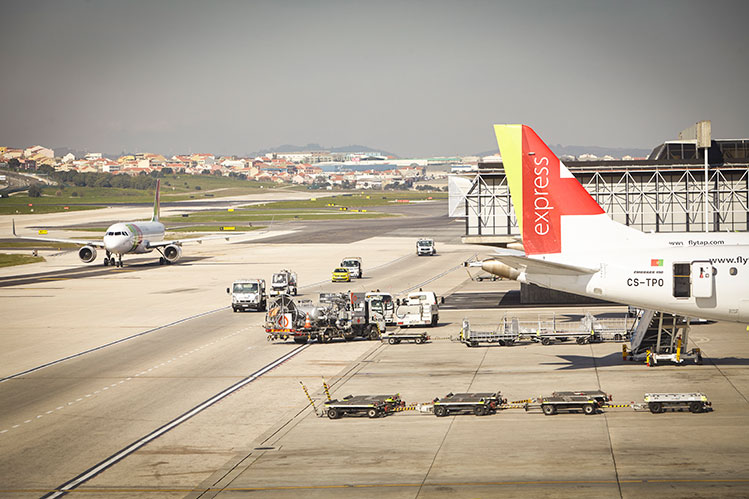
In Portugal, the 10 airports managed by VINCI achieved 12% growth in Q1 2018, with 10.4 million passengers. Lisbon further confirmed its position as an international hub with traffic rising 15.9% to 6 million. Copyright: P. Guimaraes
VINCI acquires Airports Worldwide: first UK, US airports
The breaking news just a few days before our interview was the announcement that VINCI Airports is to acquire the portfolio held by Airports Worldwide. This includes two freehold properties – Belfast International Airport and Stockholm-Skavsta Airport; two concessions – Orlando-Sanford International Airport, and Daniel Oduber Quiros International Airport in Liberia (Costa Rica); four full management contracts covering Hollywood Burbank Airport, Ontario International Airport, Macon Downtown Airport and Middle Georgia Regional Airport; and three partial management contracts covering US airports: Atlantic City International Airport, Raleigh Durham International Airport, and a share of the international terminal at Atlanta Hartsfield-Jackson International Airport.
“This is very significant,” says Notebaert. “With the acquisition of Belfast International, we take a step into the UK market, which shows our investment confidence in managing the asset despite Brexit creating a lot of uncertainty in the European air travel market. We also know that a major wave of airport privatisations is on the verge of happening in the US. So, it was very important for VINCI Airports to develop a high profile entry into this market. Last but not least, I am very pleased with the co-control stake we took in Liberia airport in Costa Rica. Costa Rica is a destination on the rise at the moment, so this considerably reinforces our strategic presence in Central and South America.”
Overall, the Airports Worldwide acquisition builds on the important announcement in January that VINCI Airports has secured a 25-year concession to operate Belgrade Nikola Tesla Airport – the gateway to the Balkans region.
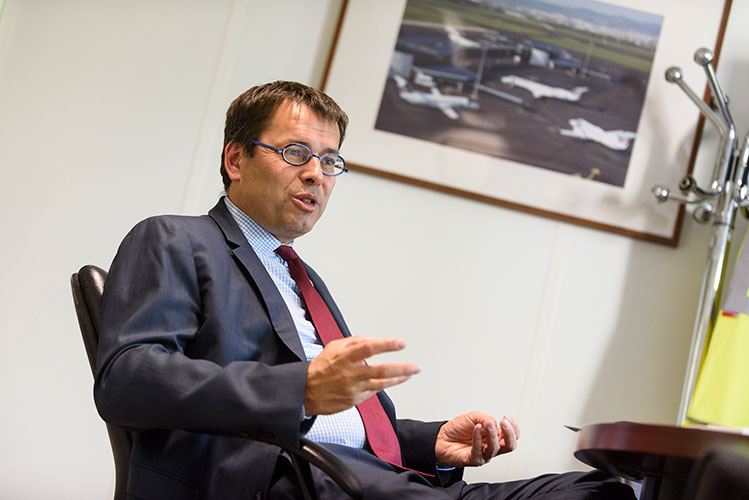
Nicolas Notebaert, CEO of VINCI Concessions and President of VINCI Airports: “I believe we have demonstrated that our integrated global model works, and that we are a solid, trusted and effective partner for government authorities and airports in diverse countries. Our vision is to bring these three qualities to more countries and regions, while adapting them to the local market so we can provide world-class airports.”
Airport privatisation trends
Notebaert expanded on his belief that VINCI Airports’ latest acquisitions supported a strong global trend towards more airport privatisation. “Emerging countries need to invest in infrastructure, but they don’t necessarily have the substantial financing capacity, nor always the required expertise. And mature countries, which need to grow and modernise, are also short of cash – largely because their political priorities are reducing deficits and public debt,” says Notebaert. “Our experience has proven successful in fast-emerging countries like Cambodia, where our capability is to quickly provide the quality airports they need as their economy expands and the middle class grows. In mature markets like Japan, Portugal, or here in France, we are also able to find the necessary investment to pave the way for further development at the local, regional and national levels.”
Of course, while some governments are cautious about privatising their airports, Notebaert is emphatic about the essential role of private investment in “unlocking the full potential”. He highlights the example of Japan, where VINCI was the first private airport operator to enter the market in 2016, operating Kansai International and Osaka Itami. “Relying on private operators to run public infrastructure is not a conventional part of Japanese culture, but our partnership was so successful that, less than a year later, the government gave us the honour of entrusting us with a third airport, Kobe.”
Notebaert says integrating with local partners is key to this success. In Kansai, VINCI partnered with Orix, a Japanese leader in real estate and financial services.
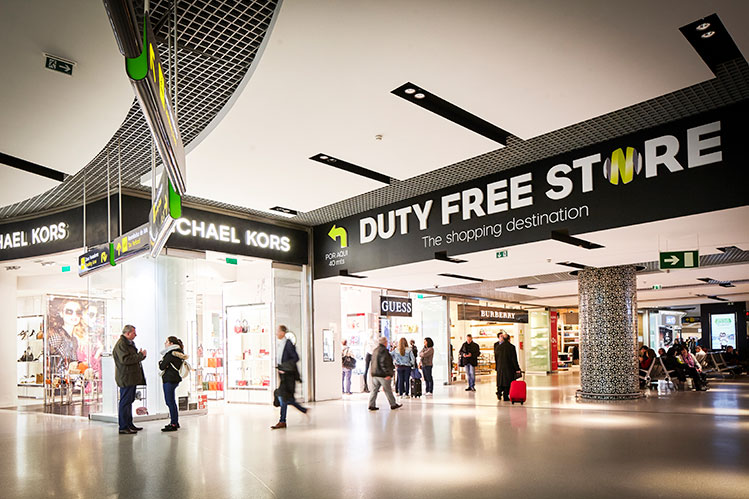
Nicolas Notebaert, CEO of VINCI Concessions and President of VINCI Airports: “We believe airports should provide a true experiential journey that revives the exciting spirit of air travel. Our non-aeronautical team understands that the best driver of commercial revenues is the creation of a passenger experience that is efficient, but also presents a truly unique commercial offer.” Copyright: P. Guimaraes
The value of (private) airport investment
Despite championing private airport ownership, Notebaert also has to face down his detractors. IATA has been particularly vocal in its criticism of privatised airports and Notebaert agrees that airports operate in a competitive environment in which they must carefully monitor pricing (notably the EU Directive on Airport Charges is currently being reviewed, with the European Commission expected to publish proposed reforms in the autumn).
“At VINCI Airports our airport charges are very competitive. We see the benefit of flexibility, either in a risk-sharing spirit with our airline partners, or to optimise investment in capacity. We apply airport charges that promote route development and growth. But to achieve this flexibility we need to be allowed to increase prices when traffic is growing, and equitably, when our airline partners are prospering; this is no different to the way that airlines manage yield, except that airports are far more exposed to regulation.”
Notebaert also thinks it is important to recognise the permanent value that investment in airports brings to communities. “Airports not only facilitate the fast movement of people and goods, and thereby foster trade and commerce, but also support job creation and serve as a catalyst for local investment. And, since airports are the first and last thing a traveller sees of a city or region, they are a vitally important showcase of specialties and heritage.” Rising to the theme, Notebaert asserts: “The first, and strongest, community benefit is to expand transportation capacity at the right time in a region’s development. Our investment approach is ‘just in time and fit for purpose’.”

VINCI was the first private airport operator to enter the Japan market in 2016, operating two of the Kansai airports (Kansai International and Osaka Itami). The partnership was so successful that, less than a year later, the government entrusted VINCI with a third airport in Kansai (Kobe). Copyright: VINCI Airports Media Library
“A great diversified wave of acquisitions” – and robust growth
VINCI welcomed 157 million passengers through its airports in 2017 – a rise of 12.4%. The positive trend has continued into 2018, with Q1 figures showing total traffic across the network up 11.6% to 38.6 million. Growth was very strong in Cambodia (+26.1%) and Portugal, particularly in Lisbon (+15.9%).
“We had sustained growth in our 12 airports managed in France (+10.6%), Japan (+10%) and Chile (+14%), and we salute the good performance of Salvador Airport in Brazil, which joined the network in January 2018 and has already grown by 6%,” says Notebaert. “We have undergone a great diversified wave of acquisitions lately and we believe all these newly-acquired airports have great potential, whether it is Belgrade, Belfast or the Airports Worldwide portfolio.”
The 12 regional airports in France saw a combined growth rate of 9.4% in 2017, and the double-digit Q1 increase builds on that with 4.2 million passengers. The high growth trend continued for Nantes Atlantique, with traffic up 18.6%. This reflects the upturn in North African traffic and strong performance on services to Portugal, Belgium, Germany, Czech Republic, and the UK.
Meanwhile, 2.3 million passengers travelled through Lyon-Saint Exupéry (+8.2%). Growth was driven by significantly higher load factors, the opening of no less than five new routes during the quarter, and a sharp increase in international traffic to North Africa, Turkey and Russia in particular.
After a transition year, traffic at Chambéry returned to growth (+16%). TUI, British Airways, and Titan Airways have all increased capacity, with additional frequencies and new routes from the UK.
“We take nothing for granted, we go to great lengths have great relationships with our airlines, to understand their needs, and then work with local communities and tour operators to ensure that both new and existing routes are successful. We are consolidating Lyon’s position as one of France’s main gateways by growing traffic and adding new routes. We not only achieved those goals in 2017, we over-performed. We even convinced Volotea, which has a base at our airport in Nantes, to begin serving Lyon. In all, 20 new routes have already been announced for the 2018 summer season, across our 12 French airports.”
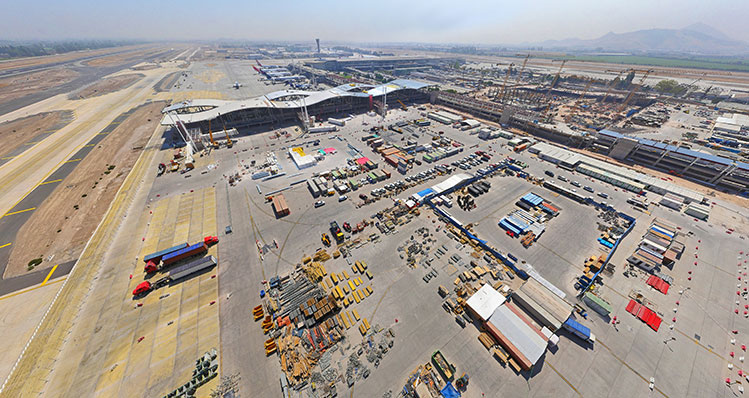
Last September, VINCI Airports laid the foundation stone for a new international terminal at Santiago International Airport in Chile as part of a renovation and extension project that will double its capacity to 32 million passengers by 2020. Copyright: VINCI Airports Media Library
Second Lisbon airport “absolutely critical – and urgent”
ANA Aeroportos de Portugal was one of VINCI Airports’ headline investments in 2013, and VINCI has subsequently invested over €200 million in both the infrastructure and passenger experience improvements at the 10 Portuguese airports it manages. Flagship projects include the complete refurbishment of Lisbon, Porto, Faro and Madeira airports.
“In addition to investing in infrastructure, we have actively worked with Turismo de Portugal to attract new airlines and new destinations, developing traffic and promoting Portugal as a tourist destination,” Notebaert explains. “This work has been carried out at all national airports since privatisation, and by the end of 2017 had resulted in a total of 51 new routes.”
Indeed, the growth in airport traffic – the latest figures show a 12% increase to 10.4 million passengers in Q1 2018 – has brought an economic boost to the country, especially in tourism. Lisbon further confirmed its position as an international hub with traffic rising 15.9% to 6 million in Q1, while Porto, which exceeded the 10 million passenger milestone in 2017, recorded 12% growth to 2.4 million in Q1.
“Tomorrow, our challenge will be to absorb this ever-increasing demand and expand Lisbon airport capacity accordingly,” says Notebaert. “To achieve that, we are ready to invest more than €500 million in the construction of a secondary airport on the Montijo air base and the development of the existing airport. The project is absolutely critical for the development of Lisbon’s airport capacity. We have made the proposal to the Portuguese Government, and the decision is in their hands. We are ready to move forward quickly and, in our opinion, it is an urgent project.”
VINCI is also developing a distinct ‘sense of place’. In Madeira, the passenger journey has been revamped to focus on the magnificent views of the coastline surrounding the airport; phase one of a €35 million expansion project.
“The new airport environment has generated a significant commercial benefit, with average spend-per-passenger increasing by 45% over the past 18 months,” says Notebaert. “In Faro, we enhanced check-in and security capacity to give passengers the opportunity to enjoy a revamped commercial offer. The commercial zone has been completely redesigned, with customised offers for Schengen and non-Schengen passengers. Processing times have been reduced and security capacity more than doubled.”
VINCI is also using its Portuguese-island duty free operations as a test bed for innovation, with a view to spreading successful initiatives throughout the network. “We want to link the new duty free experience to some of our other projects, such as the idea of queue-less airports, which will break down the normal boundaries between the landside and airside. If passengers know that they will get through security and passport control in a specific time, they will not have to rush and can stay in a central commercial area with family and friends until the last minute.”
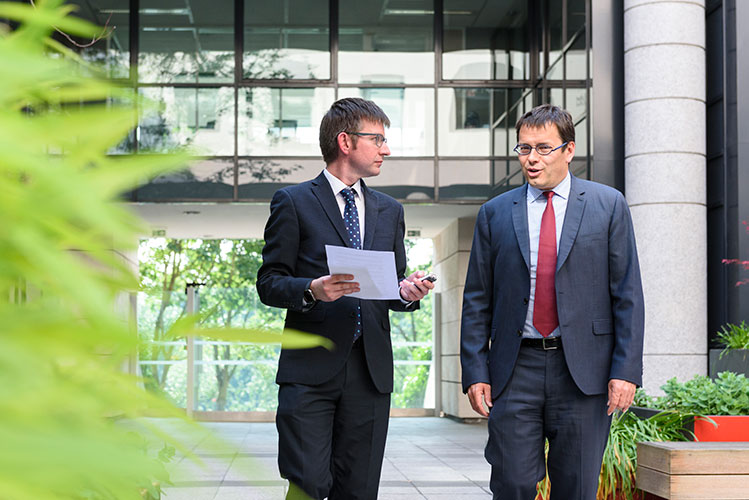
Nicolas Notebaert, CEO of VINCI Concessions and President of VINCI Airports: “Our plan is to continue exploring possibilities for external growth and bid on projects where we can create long-term value for regions and stakeholders alike. We know we can go a lot further and invest in more countries that make sense for our business model, and where we can create value.”
Commitment to sustainable development
Overall, VINCI Airports has €4 billion of investment planned across its portfolio in the next five years. Last September, it laid the foundation stone for a new international terminal at Santiago International Airport, serving Chile’s capital as part of a renovation and extension project that will double its capacity to 32 million passengers by 2020. “This is VINCI Group’s biggest construction programme outside France,” Notebaert explains. “We also have a €136 million renovation project at the newly-acquired Salvador Airport in Brazil, and have entered the second phase of the €126 million extension and renovation programme at Cambodia’s Phnom Penh and Siem Reap airports. These works demonstrate our ability to deliver highly complex projects on time without interfering with daily operations. That’s what we did in Faro, where traffic was up 20% during works, and in Osaka-Itami where the revamped terminal opened in April.”
While investing in the expansion of its airports, Notebaert says VINCI is also committed to sustainable development demonstrated by the introduction of its “AirPact” environmental policy in 2015. Key goals are to reduce energy consumption by 20% by 2020, compared with 2013 levels, and to implement a biodiversity assessment, and to obtain ISO 14001 certification at every airport.
“We go far beyond just meeting regulatory requirements, because we are convinced that by reducing our environmental impact and increasing sustainability, we can also reduce risks and costs, while improving performance,” adds Notebaert.
Another key pillar of AirPact is achieving ACI Airport Carbon Accreditation at each of VINCI’s airports. Its three Cambodian airports are the latest to achieve Level 1 Mapping, while last year Lyon-Saint Exupéry reached Level 3+ Neutrality, which Notebaert says “is a great source of pride”.
“Since 2011, 100% of the electricity consumed at Lyon-Saint Exupéry has come from renewable sources, and the airport has continually reduced its energy consumption despite major expansion and increasing traffic. The airport also has a ‘Carbon Club’ to involve all stakeholders in the reduction of greenhouse gases, and in 2017 offset 4,600 tonnes of carbon dioxide.”
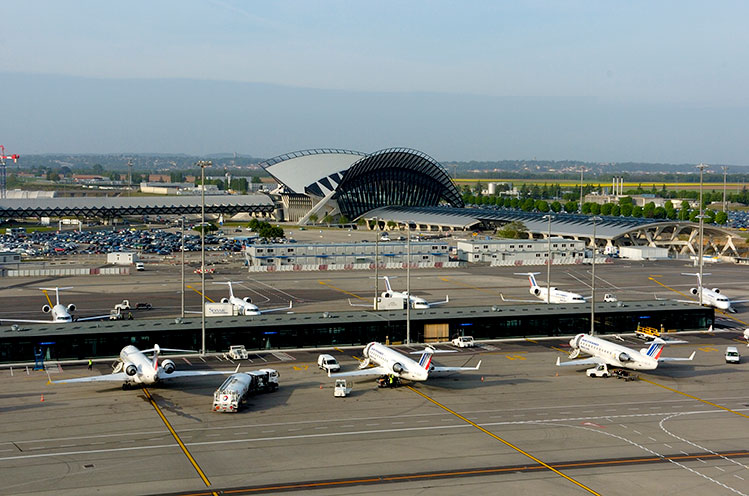
2.3 million passengers travelled through Lyon-Saint Exupéry (+8.2%) in Q1 2018. Growth was driven by significantly higher load factors, the opening of five new routes during the quarter, and a sharp increase in international traffic to North Africa, Turkey and Russia in particular. Copyright: J.F. Marin
A digital state of mind
Notebaert speaks eloquently about VINCI’s progressive approach to new technologies. “We are always projecting ourselves towards the future, and always thinking about what makes our airports unique in tomorrow’s digital world.”
Indeed, it is in the enhancement of passenger experience that knowledge exchange between VINCI’s network of airports really comes to the fore. The VINCI digital vision – ‘Think Differently’ – is very much a state of mind, and is based on internal collaboration between VINCI’s 36 airports, and cooperation with its partners (airlines, retailers, startups, etc).
“When we identify, at one of our airports, innovative initiatives in terms of passenger experience or operational efficiency, we strive to deploy them across the entire network,” Notebaert explains. “We also work in conjunction with a number of external partners, including startups, on setting up new services. Of course, simplifying the passenger journey is front and centre of these efforts, with unlimited free WiFi across the network of airports being the starting point.”
Ongoing projects include the extended roll-out of self-service bag drop kiosks, which began in Nantes; robotic valet parking at Lyon-Saint Exupéry; a virtual queuing system, which has been tested in Lisbon; intensive use of biometrics, and a baggage delivery and pick-up option.
Notebaert says VINCI encourages a “test & learn” attitude. “We can claim to have 36 airport innovation labs. Our strength lies in being able to identify an innovative idea and spread it quickly throughout our network, with real implementation before our competitors.”
VINCI Airports has experienced strong organic growth across its network, and plans to expand its global operator model to more new markets.
“Our plan is to continue exploring possibilities for external growth and bid on projects where we can create long-term value for regions and stakeholders alike. We know we can go a lot further and invest in more and more countries that make sense for our business model, and where we can create real value.”







